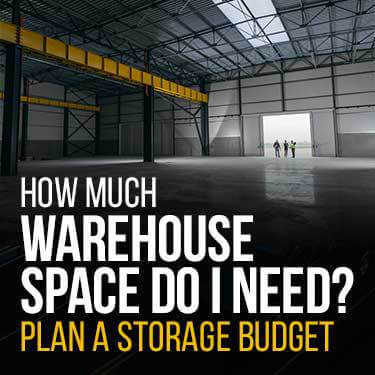
 Copy URL to Clipboard
Copy URL to Clipboard
How much warehouse space do I need for my business inventory? Looking into warehouse solutions is the next step if you’re expanding inventory or stepping up your eCommerce game. Understanding space utilization can prevent you from entering into agreements that don’t meet your business needs.
When calculating the storage needs of a business, it’s necessary to calculate the average freight dimensions and the shipping frequency. The length, width, and height measurements of standard boxes and pallets are helpful in finding the exact square footage needed. Calculations should take stacking into account if possible.
Examine the greatest impacts on your inventory storage needs and how to find cost solutions for your business budget.
Table of Contents
The majority of businesses offering physical products need to budget for some kind of warehousing space. Even if you’re in an area where industrial sectors are booming, chances are you aren’t one of the lucky few to actually own personal warehouse space. That means dealing with warehouse brokers and landlords.
Since the cost of warehousing space has been rising in recent years, it’s more important than ever to plan out space needs.
The amount of space needed also depends on everything it’s used for. Inventory storage purposes are just one of the many things taking up warehouse space.
Besides products, common space fillers at warehouses include:
Companies that run directly out of a warehouse, perhaps even handling their own fulfillment services, need to consider how much total square footage needs to be set aside for these additional needs.
Warehouse space calculations for products alone need to account for even more information.
Accurate record-keeping and year-over-year (YoY) trends will help you figure out current space requirements as well as when it’s time to upgrade to larger facilities.
For the purposes of this article, we are going to focus more on planning for inventory itself. Whether you use a third-party service for warehousing or run operations personally, inventory numbers have the biggest impact on space requirements.
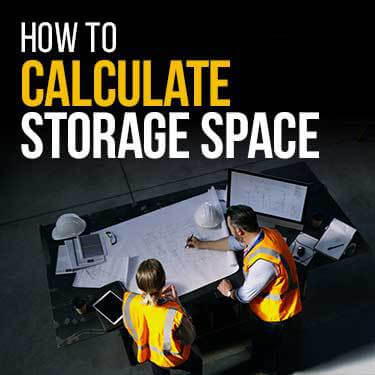
Once you’ve taken a deep and honest look at inventory movement patterns, it’s time to analyze numbers in more depth. This is easiest to do when inventory is kept in standard-sized boxes and shipped as palletized freight.
To calculate storage space, you need to determine the approximate amount of square feet taken up by the maximum amount of inventory expected for storage. If you have shipments coming in as palletized freight, there isn’t a need to measure individual boxes, just measure the dimensions of a typically loaded pallet.
For estimates, use common pallet dimensions:
These measurements represent the most common pallet base dimensions and the maximum stacked load that most warehouses will accept. You may need to adjust these dimensions to better match up with your common shipments, especially in terms of height.
Height will often depend on how stackable the goods are. If they ship in boxes, it’s not likely to be a problem once in the warehouse. In some places, as long as the pallet fits through the dock doors, height can exceed five feet. The downside is that such high pallets may not fit in standard pallet racks or be stackable.
Anything out-of-gauge (OOG), such as prebuilt furniture or car parts, may have unique storage needs. Calculating the warehouse space requirements for OOG inventory is possible, but requires a bit of dimensional creativity. If you can get reliable numbers for length, width, and height, the calculations we’re discussing are still applicable.
Before starting the actual calculations, have the following information ready:
This last point is used to provide a basic efficiency scale. Many warehouses use a table of typical utilization expectations depending on what the commodity is and how great of a variety there may be.
| Typical Products | Percentage Rates |
| Hard to stack products / OOG materials | 40% or less |
| Easy stack food grade items with high turnover rates | 50% |
| 10 to 100 non-perishable units with medium to high turnover rates | 60% |
| 2 to 10 non-perishable units with low to medium turnover rates | 70% |
| 1 to 2 non-perishable units that easily stack and have low turnover rates | 80% |
A wide variety of products and high turnover rate typically mean a lower utilization rate. When thought of in terms of efficiency, it doesn’t sound ideal, but it’s all about striking the right balance between the two.
Once you have a rate in mind that seems to match up with the cargo type, the actual calculation process can begin. The first calculation allows you to find out how much square footage is needed. We’ll do a simple calculation for someone needing to store 30 pallets that can be stacked four pallets high and have a utilization rate of 45%.
To calculate the total square feet needed, go through the following steps:
The math may not be very fun, but having a reliable estimate of your warehouse space requirements will help you narrow down your search. Let’s see how these steps look when we plug in the dimensions and rates mentioned earlier.
| Number of pallets / stacking height | 30 ÷ 4 | 7.5 |
| Pallet length x width (in feet) | 3.5 x 4 | 14 ft |
| Pallet sq ft x number of stacks | 14 x 7.5 | 105 ft² |
| Sq feet per stack x utilization rate | 105 ft² ÷ 45% | 233.34 ft² |
The result of these steps is meant to provide you with a reasonable estimate of storage needs. While the majority of warehouses will use the measurements we’ve reviewed, it’s always best to double-check.
It’s also possible to come up with a price estimate for product storage once the estimated square footage is calculated. Rental rates are based on price per square foot. Other factors are considered, but space is the one that affects rates the most.
If you have opted to rent out an entire warehouse, finding a more exact utilization rate is necessary. Tracking these rates helps ensure the efficient use of space and serves as a guide for adjustments.
Calculating space utilization begins with finding the cubic footage of the warehouse where products are stored.
Because of the use of pallet racks and forklift systems, vertical storage is easier than ever. With the right layout, warehouse owners and renters are able to account for more than just floor space.
Use the following steps to calculate a warehouse’s storage capacity in cubic feet:
There will still be some margin of error since it’s difficult to account for every foot of unusable space. As with the formula for square footage, it’s meant to provide reasonable estimates.
A warehouse with 20,000 square feet of usable space and a ceiling clearance of 30 feet will have 600,000 cubic feet of space. The next step is to figure out how many cubic feet the inventory takes up. This means measuring the volume of everything that’s going to be stored in the warehouse.
If you’ve already taken the time to measure the square footage of incoming shipments, all that’s required is to measure the height of the pallet being expected.
Let’s assume that your boxes are stacked five feet high on 175 standard-sized pallets measuring three and a half by four feet.
Realize that if there are different-sized pallets, there will be a need to find more than one set of volumes. Either way, so long as the numbers have been added up correctly, there shouldn’t be a problem in completing the last step.
The final step of calculating utilization is to divide the inventory’s cubic size by the warehouse’s total storage space.
A utilization rate of 2.04% is incredibly low, even accounting for the space taken up by people and equipment. If these calculations represented an actual warehouse, it would be a sign that space is being severely underused.
A rate of 22% to 27% utilization is actually ideal. It means there is room for employees to work safely and leaves enough open space for packing and kitting services as needed. Again, utilization measure is more important to those taking care of their own fulfillment services or have who have an interest in running a warehouse service.
Someone simply looking for storage space and wanting to come up with a basic idea of their needs can focus on the square footage calculations reviewed earlier.
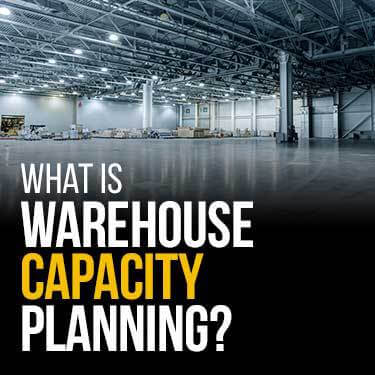
Expanding to a warehouse, either for the first time or because a current space has become outgrown, needs to be done with careful consideration.
Warehouse capacity planning refers to how a business analyzes its inventory, fulfillment services, and employee needs to determine storage needs.
Getting too much or too little warehouse space has a negative impact on business. Too big means you’re paying for space that isn’t turning over product. A space that is too small limits your inventory levels and prevents business growth down the line.
There are two aspects of warehouse capacity planning that need to be addressed.
The best way of taking these factors into account is to consider what has the greatest impact on either of them.
The day-to-day activities and predictable patterns of a business provide a starting point for an in-depth look at immediate needs. These are the common factors in play whether the business is eCommerce based or brick-and-mortar
In terms of supply, capacity planners should consider:
Many retail-based businesses increase their safety stock to prepare for the holiday season. Warehouses maintaining agricultural products may need to handle multiple growing and harvest seasons.
Failing to consider your peak season needs may result in shortages that hurt your business image long-term. Depending on how extreme the peak is, you may even want to consider temporary expansions through outsourcing.
Outsourcing during peak business times is a valid option and there are a number of fulfillment centers and 3PL services available to assist you during those times. The trick is to plan ahead because you won’t be the only business with the same idea especially if your competition is nearby.
Partnering with a reliable and trustworthy 3PL regularly opens up many business opportunities.
Planning for the future is a little different. Long-term growth is about more than just predicting seasonal highs and lows. It’s about making logical assumptions about business growth and future product trends.
Long-term consideration for warehouse capacity planning includes studying:
After the research is done, the planning begins. Growth doesn’t look the same in every business and it doesn’t always mean a bigger warehouse or more space. It might mean outsourcing, switching to dropshipping practices, or offering different types of products.
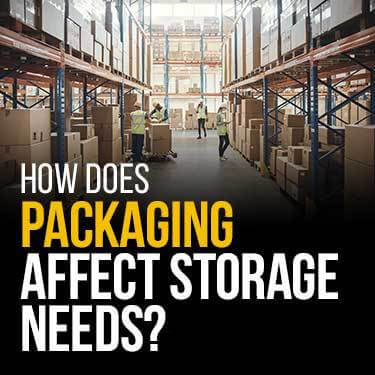
Have you ever ordered something small, perhaps a new computer mouse or office keyboard, only for it to arrive in a box several times its size? You may even have had to dig through a mountain of air packs or shredded paper just to find the item in question.
As a client, it’s a mild inconvenience. As a business, it should make you take a look at how your own items are being stored and packaged.
Ask yourself a few questions about your own inventory practices
Even if you can’t control how your supplier works, there is a possibility that you can come up with your own, more efficient system when receiving or sending out merchandise. Weigh the pros and cons of any switch.
All forms and types of packing have their benefits. Focus on finding the balance between space and quality that works for your business.
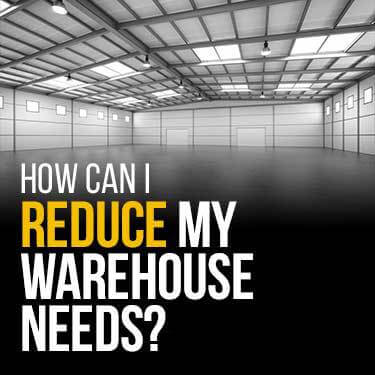
When looking to streamline parts of the business and free up funds for other expenses, consider reducing current warehouse expenses. This may also be the case if recent audits on current use revealed that downsizing was necessary.
There are a number of different ways to reduce warehouse needs, such as:
It’s possible to save money by reducing the amount of space you need to rent or by improving your efficiency so that more money is being generated by the same amount of space. Either way means more money becomes available.
If growth is the goal, improving current space use is a little better. This way you can stay in the same location and not add moving expenses to the budget.
Warehouse slotting is an organization system meant to optimize inventory for easier picking.
The more products a business offers, the more time picking takes. An eCommerce business that sells cosmetics can have hundreds of unique units. An order of lipstick, blush, and eye shadow gets complicated real quick when the client wants multiple shades and finishes of each.
Warehouse slotting organizes products by their most relevant characteristic:
Whichever trait is used, the idea is to group them the same way each time. Products that are usually ordered together can be stored near each other. Open bins can be used to make selection faster.
Check out our article on managing warehouse inventory for more tips on improving productivity.
Another way of reducing warehouse needs is to outsource all of your operations to a third-party logistics provider, or 3PL. These companies focus on running warehouses and fulfillment services for all kinds of businesses.
By fully outsourcing your warehousing needs to a 3PL it’s possible to eliminate individual budgets for:
Paying for the services of a 3PL warehouse provider is likely to cost more than rent for a warehouse. The savings come from not having to have an additional budget for all the other things needed beyond space.
This is important when you look at the rising costs of actually operating your own warehouse.
| Year | Average Cost Per Square Foot |
| 2017 | $6.53 |
| 2018/19 | $7.79 |
| 2020 | $7.81 |
| 2021 | $7.91 |
The numbers may not seem like much at first, but let’s do some simple math. A 5,000-square-foot warehouse operating budget in 2021 was estimated at $7.91 per square foot. The total annual cost comes out to $39,550. That’s $3,295 a month in operating costs.
If working with a 3PL brings down monthly costs without sacrificing business opportunities, it's worth checking out.
How much control you choose to keep over warehousing depends on the agreement with the 3PL. It’s possible to arrange storage space only, or even provide your own packing supplies with unique branding.
As with any other decision, the pros and cons need to be carefully considered. Whether you choose to fully outsource warehousing needs or limit it to peak seasons, Fulfillment and Distribution has a solution.
Running any kind of business means owners have to make some tough decisions. Fulfillment and Distribution, powered by R+L Global Logistics, has a way to make it a little easier.
Our logistics experts can help you find out just how much warehouse space you need and provide you with services to make your distribution and fulfillment needs a breeze.
Streamline your business by taking advantage of a variety of services:
Call Fulfillment and Distribution today at (866) 989-3082 to speak with an industry specialist. Have immediate warehousing needs? Complete an online form now and get a tailored service quote.
